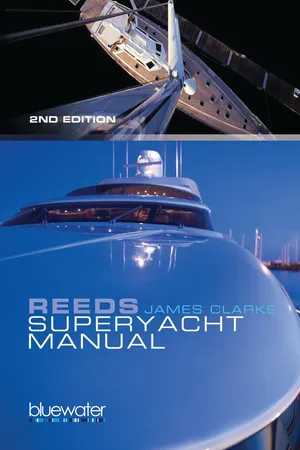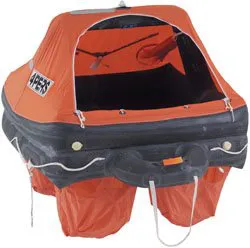
- 400 pages
- English
- ePUB (mobile friendly)
- Available on iOS & Android
eBook - ePub
About this book
Reeds Superyacht Manual, published in association with Bluewater
Training, is a complete reference and training manual for everyone
involved with large yachts, from deck-hands to captains, as well as for
leisure boaters and sailors. Covering the course syllabus for all
career levels to Officer of the Watch, with explanatory diagrams and
photographs, this user-friendly book includes:
- the key information for all courses required from
basic training through Yachtmaster ™ to Officer of the Watch (Yacht) - comprehensive coverage of: safety, sea survival,
first aid, fire fighting, navigation and radar, seamanship,
meteorology, marine radio, general ship knowledge - additional information on the career path and
marine law, including international and flag state requirements - full text of the Collision Regulations; single letter flag and Morse codes.
This is the complete on-board reference, whether you are starting out
in yachting and looking for the essentials of safety and navigation, or
you are seeking a clear understanding of the operation and manning of
large yachts and the legislation concerning them.
Frequently asked questions
Yes, you can cancel anytime from the Subscription tab in your account settings on the Perlego website. Your subscription will stay active until the end of your current billing period. Learn how to cancel your subscription.
At the moment all of our mobile-responsive ePub books are available to download via the app. Most of our PDFs are also available to download and we're working on making the final remaining ones downloadable now. Learn more here.
Perlego offers two plans: Essential and Complete
- Essential is ideal for learners and professionals who enjoy exploring a wide range of subjects. Access the Essential Library with 800,000+ trusted titles and best-sellers across business, personal growth, and the humanities. Includes unlimited reading time and Standard Read Aloud voice.
- Complete: Perfect for advanced learners and researchers needing full, unrestricted access. Unlock 1.4M+ books across hundreds of subjects, including academic and specialized titles. The Complete Plan also includes advanced features like Premium Read Aloud and Research Assistant.
We are an online textbook subscription service, where you can get access to an entire online library for less than the price of a single book per month. With over 1 million books across 1000+ topics, we’ve got you covered! Learn more here.
Look out for the read-aloud symbol on your next book to see if you can listen to it. The read-aloud tool reads text aloud for you, highlighting the text as it is being read. You can pause it, speed it up and slow it down. Learn more here.
Yes! You can use the Perlego app on both iOS or Android devices to read anytime, anywhere — even offline. Perfect for commutes or when you’re on the go.
Please note we cannot support devices running on iOS 13 and Android 7 or earlier. Learn more about using the app.
Please note we cannot support devices running on iOS 13 and Android 7 or earlier. Learn more about using the app.
Yes, you can access Reeds Superyacht Manual by James Clarke in PDF and/or ePUB format. We have over one million books available in our catalogue for you to explore.
Information
eBook ISBN
9781408107690Edition
2PART ONE
Safety
1 • Basic sea survival
➤ Training for emergencies ➤ Survival priorities ➤ Survival equipment ➤ Abandoning ship ➤ Man overboard (MOB)
This chapter reflects the STCW 95 requirements for the Personal Survival Techniques module as part of basic safety training. Knowledge of survival craft medicine in Chapter 2 is assumed.
➤ TRAINING FOR EMERGENCIES
Hazardous situations happen frequently enough to make training for them meaningful. Many emergencies on board are preventable if all on board carry out proper maintenance, navigation, watch and bridge procedures, as well as training. Fire is the prime reason for abandoning ship so a positive stance on fire prevention is essential. The others, in order of incidence, are: collision, grounding, and sinking.
➤ SURVIVAL PRIORITIES
To survive, you need, in this order to:
1 Breathe (ie not drown)
2 Keep warm
3 Drink
4 Eat and to be rescued
If you can’t breathe, you won’t be worrying about keeping warm, let alone where the next meal is coming from. These priorities will determine your preparations and actions in a survival situation. Most abandonment deaths are from drowning or hypothermia, and occur soon after the incident. The need to be rescued requires action too – you might be able to survive without food for up to 30 days, so food and rescue can be regarded as of equal importance. Remember, you haven’t survived until you’ve been rescued.
To be a survivor, you will need knowledge, equipment, and the will to survive. These three things are interdependent, but the most important is the will to survive. This comes from deep within you, and is strengthened by belief in the possibility of rescue, however bad things may look. There are countless stories of apparently miraculous rescues when it seemed impossible. To survive, it is up to you to maintain that belief. The importance of this cannot be overstated – it is the very foundation of survival.

➤ SURVIVAL EQUIPMENT
The best piece of survival equipment you have is your yacht. In the Fastnet storm of 1979, the majority of the abandoned yachts were recovered still floating. There are many other stories of abandoned yachts and ships that have been recovered in reasonable condition after an emergency has passed. So abandoning must be the last resort. Any extra time on board can be put to good use in preparing to abandon – lives will be saved by the spare lifejackets you packed at the last moment.
Lifejackets
There are three main types:

Fig. 1.1
SOLAS/MCA approved foam These are uncomfortable and bulky; they restrict movement and take up a lot of stowage, but are the best for an abandonment; with no air to escape they are nearly 100 per cent reliable.
SOLAS/MCA approved inflatable These have double air chambers to counter the risk of puncture or slow deflation. They are intended primarily for use by rescue boat crews and when working on deck. They are sometimes fitted with a face mask and are extremely good in foul weather.
Essential equipment in order of priority
| To breathe | | Lifejackets |
| To stay warm | | Immersion suits and/or warm clothing, oilskins, liferaft, lifeboat, thermal protective aids* (TPAs), blankets |
| To drink | | Water* |
| To eat | | Food*, fishing gear* |
| To be rescued | | EPIRB, handheld VHF, SART, signalling mirror*, flares*, radar reflector* |
| | | |
| | | (* may be in the liferaft, but perhaps not in adequate quantity) |
Leisure lifejacket Often 150 Newtons with one chamber, so they are compact and comfortable to wear when folded. They are not approved, but may be useful when there is no statutory requirement and a lower level of protection is justified.
The SOLAS/MCA approved lifejackets found on coded vessels should be used when abandoning. They will have the following properties:
• Non flammable and rot-proof manufacture.
• The option to wear inside out or clearly marked for correct donning.
• Durability to allow jumping from 4.5m.
• Air tightness to retain 95 per cent buoyancy for 24 hours.
• A whistle, light and retro-reflective tape.
• Capability to lift the mouth of an immobile person 120mm clear of the water, and to turn an unconscious person over so that their mouth is clear of the water in less than five seconds.
• A shape that allows swimming.
• Markings showing the manufacturer’s name, SOLAS and/or MCA approved, year of manufacture, and ‘person of 32kg or more’.
Immersion suits
Approved immersion suits are required for each person on board coded vessels unless in warm waters, and unless davit-launched or enclosed lifeboats are fitted. Suits may be either insulated or uninsulated; the latter should always be worn over warm clothing. Suits are designed either to be worn with a lifejacket or to have sufficient built-in buoyancy to make this unnecessary.

Immersion suit. Photo Crewsaver
Suits should be capable of being unpacked and put on without assistance within two minutes. They should allow the wearer to perform normal duties during abandonment, to jump from a height of not less than 4.5m, to climb down a vertical ladder, to swim a short distance, and to board a survival craft. Precise limits of the wearer’s permitted temperature drop over time are specified. An immersion suit covers the whole body except for the face and is highly visible.
Liferafts
A liferaft for a small yacht is shown here. Water pockets hang from the raft to provide stability when launched. A boarding rung and foot strap are provided to aid entry.

Suitable liferaft for a small yacht. Photo: Viking Life-Saving Equipment
Davit launched liferafts
Some larger liferafts are designed to be davit launched after being boarded. These rafts are constructed to be very durable and readily take the weight of their full complement when suspended. They are also sturdy enough to withstand contact with the ship’s side.
Liferaft hydrostatic release
Liferafts stowed on deck ready for use are secured using a hydrostatic release, which cuts the lashing link, and releases the liferaft if the vessel sinks. The liferaft painter remains attached to the ship via a so-called weak link (red in the figure) – one that is strong enough to trigger inflation of the raft, but will then break under the force of the raft’s buoyancy. The release prevents the liferaft sinking with the ship, and damage from the painter being torn off. The release itself is a spring-load...
Table of contents
- Cover
- Title page
- Contents
- Introduction
- Part 1 • SAFETY
- Part 2 • NAVIGATION
- Part 3 • METEOROLOGY
- Part 4 • MARINE RADIO
- Part 5 • ADVANCED NAVIGATION
- Part 6 • GENERAL SHIP KNOWLEDGE
- Part 7 • REGULATION
- APPENDICES
- eCopyright